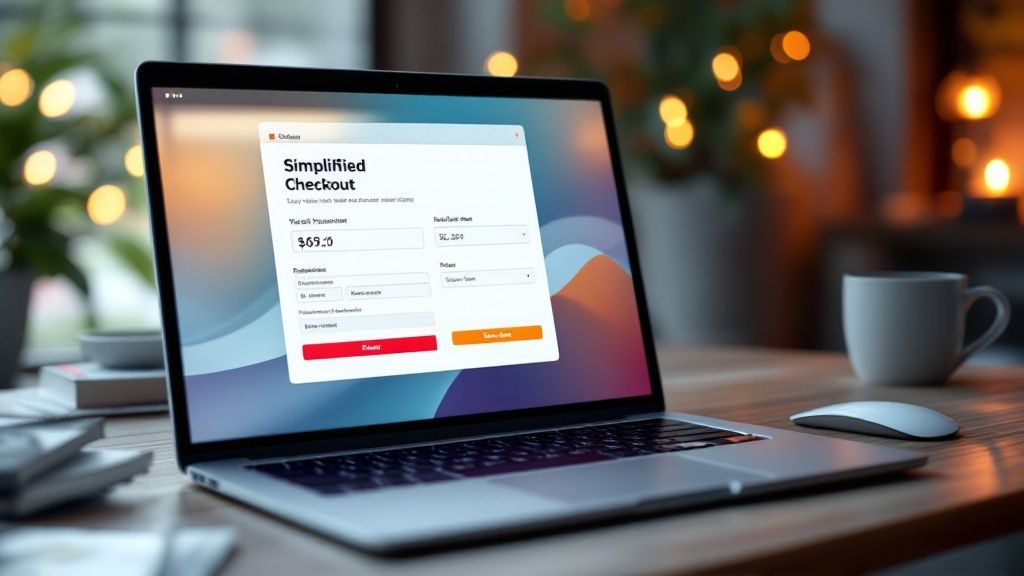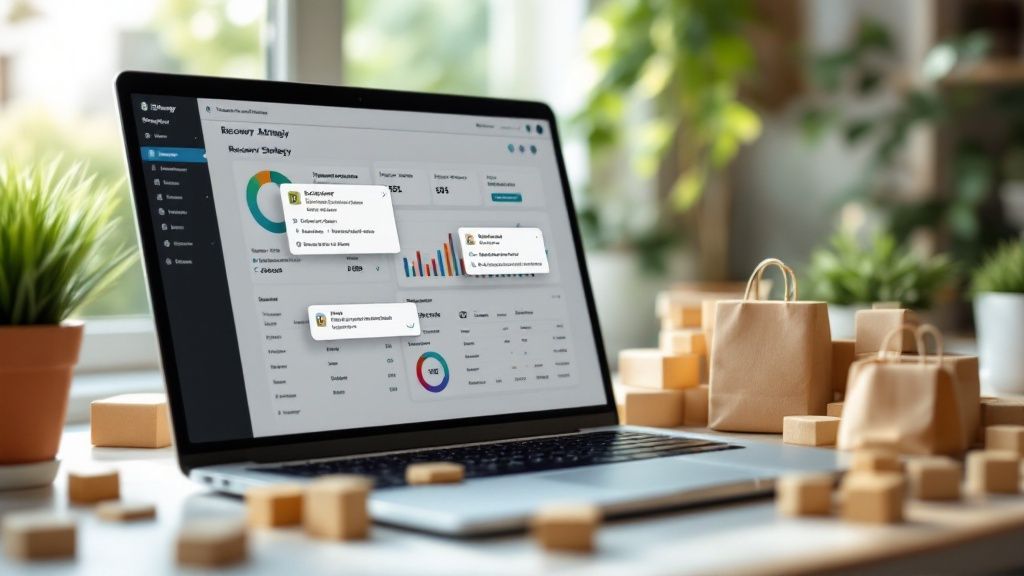How to Reduce Shopping Cart Abandonment: Top Tips
March 21, 2025

Understanding The True Cost of Abandoned Carts

Every abandoned shopping cart represents a lost sale and potential revenue. Beyond this immediate loss, there are hidden costs associated with cart abandonment. These costs can significantly impact your business's profitability. It's not just about the single transaction; it's about the cumulative effect of lost customers and the resources invested in acquiring them.
Calculating Your Abandonment Rate
Understanding your abandonment rate is the first step towards improvement. The calculation is simple: Divide the number of completed purchases by the number of initiated checkouts. Subtract that result from 1, then multiply by 100.
For example, with 100 initiated checkouts and 30 completed purchases, your abandonment rate would be 70%.
Benchmarking Your Performance
How does your rate compare to the industry average? This crucial comparison helps contextualize your performance and identify areas for improvement. The overall average cart abandonment rate offers a valuable benchmark. According to the Baymard Institute, the average documented online shopping cart abandonment rate is approximately 70.19%. This means almost three-quarters of online shoppers don't complete their purchases.
Understanding this average helps businesses set realistic goals. By improving checkout usability and addressing common abandonment reasons, companies can aim to lower their rates below this average and increase conversions. However, remember that averages can be misleading. Industry benchmarks provide a more nuanced perspective.
Industry Benchmarks
Different industries face unique challenges and customer behaviors, leading to varying abandonment rates. Industries with complex products or longer consideration periods often see higher abandonment. Conversely, those selling everyday essentials typically experience lower rates.
To help illustrate this, let's take a look at the table below. It provides average abandonment rates across different sectors and suggests benchmark targets.
Cart Abandonment Benchmarks by Industry
This table provides average cart abandonment rates across different industry sectors to help businesses understand how their performance compares to industry standards.
| Industry | Average Abandonment Rate | Benchmark Target |
|---|---|---|
| Apparel | 72% | 65% |
| Electronics | 68% | 60% |
| Food & Beverage | 65% | 58% |
| Travel | 81% | 75% |
If you're selling apparel, a 72% abandonment rate might be considered average for your industry. By understanding best practices and implementing targeted strategies, aiming for a 65% rate could be a reasonable goal. This data helps businesses set informed targets tailored to their specific market.
Identifying Drop-Off Points
Knowing where customers abandon their carts is as important as knowing how many. Analyzing your checkout funnel reveals specific pain points. Are customers dropping off at the shipping information stage? Or during payment selection? Pinpointing these friction areas is key to developing effective solutions. This leads to the next crucial step in reducing cart abandonment: addressing potential price shock.
Eliminating Price Shock: The Transparency Revolution
Unexpected costs during checkout are a major deterrent for online shoppers. This price shock can severely impact your conversion rates and damage customer trust. Instead of surprising shoppers with hidden fees, prioritize transparency to build confidence and encourage completed purchases. This involves clearly displaying all costs upfront and strategically presenting pricing information throughout the customer journey.
Preemptive Price Display: Setting Clear Expectations
One of the most effective ways to combat shopping cart abandonment is to be upfront about all costs. Displaying shipping fees, taxes, and any other additional charges early in the checkout process significantly reduces the likelihood of customers abandoning their carts. This practice builds trust and avoids the negative impact of unexpected costs at the final stage. Think of it like ordering at a restaurant: you expect to see the price of each dish before you order, not as a surprise on the bill.
This upfront approach empowers customers to make informed decisions, minimizing last-minute surprises. Providing clear explanations for any unique pricing structures further enhances transparency and builds customer confidence.
Strategic Free Shipping Thresholds
Offering free shipping, or free shipping above a certain purchase amount, is a powerful incentive for customers to complete their purchases. This is especially important considering 48% of online shoppers abandon their carts due to unexpected shipping and tax costs. Learn more about cart abandonment statistics here. This strategy not only encourages higher order values but also directly addresses a major pain point for online shoppers.
Experiment with different thresholds to find the optimal balance between encouraging larger purchases and maintaining profitability for your business.
Testing and Optimization: Finding the Right Balance
Finding the ideal pricing strategy requires careful testing and analysis. A/B testing different pricing models, such as displaying prices inclusive of tax versus adding tax at checkout, can provide valuable insights into customer behavior. This data-driven approach allows you to tailor your pricing presentation to your specific target audience.
You might find that displaying prices with taxes included reduces friction for some customer segments while having the opposite effect on others. By tracking key metrics like conversion rates and average order value across different test groups, you can make informed decisions to optimize your pricing strategy.
Building Trust Through Transparency
Transparency in pricing is more than just displaying numbers; it's about creating a clear and predictable experience for the customer. This builds trust and strengthens the customer-brand relationship. Just as a clear return policy builds confidence, transparent pricing fosters a sense of security, leading to increased conversions and customer loyalty. By embracing transparency, you position your brand as trustworthy and customer-centric, ultimately contributing to a more positive shopping experience.
Crafting a Frictionless Path to Purchase

A seamless checkout is essential for turning potential customers into paying ones. One of the biggest reasons for shopping cart abandonment is a complicated checkout process. By simplifying the path to purchase and minimizing friction points, you can create an intuitive flow that guides customers effortlessly towards completing their order. This section explores key strategies for achieving this frictionless experience.
Streamlining Form Fields: Less is More
Long, complicated forms can overwhelm customers and lead to frustration. Every unnecessary field increases the chance of abandonment. Critically evaluate each field in your checkout form. Remove any fields that aren't absolutely essential. For example, do you really need both a shipping address and a billing address if they are often the same? Offering options like auto-filling addresses or using information from existing accounts (like Google or Apple Pay) can further streamline the process.
Progress Indicators: Guiding the Way
Imagine navigating a maze without a map. That’s often how a checkout process feels without clear progress indicators. A visual progress bar or numbered steps can reduce customer anxiety by clearly showing them how far they’ve come and how much is left. This clear roadmap sets expectations and motivates customers to reach the final step.
Guest Checkout: Removing Barriers
Requiring account creation can be a significant obstacle to completing a purchase. While accounts can be beneficial for building long-term customer relationships, they shouldn't be mandatory. A guest checkout option allows customers to purchase quickly, without committing to an account. This is especially helpful for first-time buyers who may be hesitant to share their information.
Mobile Optimization: Thumb-Friendly Experiences
With the rise of mobile shopping, optimizing the checkout experience for smaller screens is crucial. Mobile optimization involves more than just a responsive website. It means designing a truly thumb-friendly experience, with large buttons, easily tappable fields, and a streamlined layout. Form fields should be appropriately sized for mobile input, ensuring the entire checkout process is comfortable on a smaller screen.
UX Enhancements: Small Changes, Big Impact
Even small improvements in user experience (UX) can significantly impact completion rates. Smart defaults, like pre-selecting the most common shipping method, can save customers time and effort. Inline validation, providing real-time feedback on form fields, prevents errors and frustration. These small details create a more intuitive and positive experience. Using tools like Checkout Links can simplify the creation of dynamic links that pre-load customer information, further reducing friction. This can improve conversion rates by removing the need for manual data entry. By continually optimizing these small details, you create a checkout experience that encourages purchases.
Rescue Lost Sales: Building Cart Recovery Campaigns That Convert
An abandoned online shopping cart doesn't always mean a lost sale. In reality, these abandoned carts offer a prime opportunity to reconnect with potential customers and recover those sales. This is where a well-designed cart recovery campaign plays a vital role. These campaigns, often using email as the primary channel, offer a direct way to remind shoppers about the items they left behind and encourage them to complete the purchase.
The Power of Abandoned Cart Emails
Email marketing remains a highly effective method for cart recovery. Its personalized nature allows businesses to send targeted messages directly to a customer's inbox. For instance, data reveals that abandoned cart emails have a remarkable 39.07% open rate and a 23.33% click-through rate. What's more, sending multiple follow-up emails can significantly increase revenue. Campaigns that utilize three emails generate considerably more revenue than those that rely on a single email. More detailed statistics can be found here. This highlights the importance of a persistent, yet well-timed, approach to re-engaging potential buyers.
Timing is Everything: The Email Sequence
The timing of your recovery emails is essential. The first email should be sent within one hour of cart abandonment, capitalizing on the customer's immediate interest. This initial message serves as a gentle reminder and can include incentives such as free shipping or a small discount. A second email can be sent within 24-48 hours, reinforcing the product's benefits and perhaps offering a slightly larger discount. A final email sent after 72 hours can instill a sense of urgency, perhaps emphasizing limited stock or a final discount offer.
Crafting Compelling Subject Lines and Content
Your email's subject line is the first thing a customer sees, so make it captivating. Keep it short, personalized, and focused on the benefits. For example, instead of a generic "You left something in your cart," consider something more engaging like "[Customer Name], your favorite items are waiting!" The email content itself should be concise, visually appealing, and highlight the value of the products left behind. High-quality product images and clear calls to action are crucial for driving conversions.
Segmentation for Maximum Impact
Recognize that not all customers are the same; therefore, your cart recovery campaigns should reflect this diversity. Segmentation, based on factors like cart value, customer purchase history, and browsing behavior, allows you to tailor your messaging for optimal results. For example, a high-value cart might necessitate a personalized email with a direct contact to customer service, while a first-time customer might benefit from reassurance about security and shipping procedures. Checkout Links offers the ability to create dynamic links that pre-fill customer information at checkout, streamlining the recovery process. More information on reducing cart abandonment can be found here. This personalized approach can significantly improve your conversion rates.
Building Trust When It Matters Most: Checkout Security

Security concerns play a major role in shopping cart abandonment. A secure checkout builds customer confidence, just as a streamlined checkout reduces friction. Effectively displaying trust signals can significantly decrease abandonment rates by assuring customers their information is safe. This involves strategically placing elements that convey security and reliability throughout the checkout process.
The Power of Security Badges and Trust Seals
Security badges, such as those from Norton or McAfee, serve as visual cues, assuring customers your site is protected. These badges can greatly influence purchasing decisions, especially for first-time buyers. Simply displaying them isn't enough; placement is crucial. Strategically position them near payment fields and the submit order button to maximize their impact. This reinforces the message of security at the critical moment of purchase.
Leveraging Customer Testimonials and Social Proof
Social proof is a powerful tool for building trust. Displaying positive customer testimonials or reviews near the checkout can reassure hesitant shoppers. Avoid overwhelming the customer with too many. Select a few concise, impactful testimonials directly addressing security concerns or highlighting positive experiences. This reinforces security and encourages conversions without disrupting the checkout flow.
Clear Privacy Policies and Reassurances
Transparency about data handling is essential. Clearly state your privacy policy and data protection measures. Use simple language that assures customers their information is handled securely. Reiterate these assurances near the checkout to address lingering concerns. A short statement like, "Your payment information is encrypted and protected," can greatly reduce anxiety.
Tailoring Trust Signals to Product Categories and Price Points
Different products require different trust-building strategies. High-value items demand stronger assurances than everyday purchases. Tailor your trust signals to the specific product category and price point. High-ticket items might benefit from offering phone support during checkout or more detailed security information. Lower-priced items may only need secure payment badges and clear privacy statements. You might be interested in: How to master checkout optimization. This nuanced approach ensures your trust-building efforts align with customer expectations and perceived risk.
Testing and Optimization: Finding the Right Combination
There's no single solution for building trust. Experiment with various combinations of security badges, testimonials, and privacy reassurances. A/B test different placements and messaging to find what best resonates with your target audience. This data-driven approach helps you continually refine your strategy and optimize the checkout experience for maximum conversions. Analyzing the results reveals the most effective combination of trust signals for your customer base.
Winning Strategies for High-Ticket Purchase Completion
High-ticket items, like luxury watches or custom-designed furniture, often experience higher cart abandonment rates because of the significant investment they require. This necessitates a more thoughtful approach than simply offering discounts or free shipping. These purchases demand strategies that address the psychological barriers associated with large sums of money. This means understanding the customer's decision-making process and adapting your approach accordingly.
Overcoming Decision Paralysis: Addressing Purchase Hesitation
Decision paralysis is a common hurdle in high-ticket purchases. Customers often feel overwhelmed by the implications of a substantial expense. To counteract this, offer comprehensive product information, including high-quality images, videos, and detailed specifications.
Consider incorporating user-generated content, like reviews and testimonials, to foster trust and social proof. This can give hesitant buyers the confidence to proceed.
Financial Flexibility: Implementing Effective Financing Options
Price can be the biggest deterrent. Offering financing options, such as payment plans or installments, can make the purchase more manageable and boost conversions. This alleviates the immediate financial burden and expands accessibility to a wider customer base.
For example, allowing customers to pay for a premium appliance over 12 months can lessen the perceived initial cost.
Creating Urgency Without Pressure: The Subtle Art of Persuasion
While creating a sense of urgency can be effective, avoid aggressive tactics that could compromise brand integrity. Subtle cues, such as highlighting limited stock or impending price increases, are often more persuasive than flashing banners or countdown timers. This approach respects the customer's decision-making process without resorting to high-pressure sales tactics.
Cart abandonment rates vary significantly across industries. Sectors like home furnishing and jewelry see particularly high rates, often over 80%, due to higher price points and longer consideration periods. Learn more about cart abandonment statistics from resources like Hotjar. Businesses can mitigate this with strategies like offering price comparisons and in-depth product information.
Enhanced Product Information at Critical Decision Points
Strategic information placement is essential. Providing extra product details or customer service access directly within the cart or checkout page can resolve last-minute doubts. Consider it akin to having a knowledgeable sales representative readily available during checkout.
Tailored Retargeting for Considered Purchases
Retargeting campaigns for high-ticket items should differ from those for impulse buys. Focus on nurturing customer relationships and providing ongoing value, rather than merely reminding them of abandoned carts.
This might involve sending targeted emails with related product details, exclusive content, or personalized offers. This nurtures the lead and maintains product visibility throughout the extended decision-making process. Checkout Links can be used to create personalized links that pre-fill customer information and apply relevant discounts, minimizing friction in returning to the checkout process.
To further illustrate the effectiveness of different abandonment reduction techniques, let's explore a comparison table.
This table compares several abandonment reduction techniques and their associated effectiveness metrics across implementation difficulty, cost, and average conversion improvement.
| Strategy | Implementation Difficulty | Cost Level | Average Conversion Improvement |
|---|---|---|---|
| Offering Financing Options | Medium | Medium | 10-20% |
| Enhanced Product Information | Low | Low | 5-10% |
| Personalized Retargeting | Medium | Medium | 15-25% |
| User-Generated Content | Low | Low | 2-5% |
| Subtle Urgency Tactics | Low | Low | 1-3% |
As you can see, while all strategies can contribute to reducing cart abandonment, personalized retargeting and offering financing options often yield the highest conversion improvements. However, even simpler, low-cost strategies like enhancing product information and incorporating user-generated content can have a noticeable positive impact. Choosing the right combination of strategies depends on your specific business and target audience.
Beyond Implementation: Measuring What Actually Works

Reducing shopping cart abandonment isn't a one-time fix. It's a continuous process of optimization and refinement. Implementing strategies is only the first step. Accurately measuring their effectiveness is equally critical. This requires a robust system for tracking, analyzing, and iterating on your approach. This section explores how to build such a system.
Setting Up Proper Event Tracking
Knowing where customers abandon their carts is crucial. Event tracking, using tools like Google Analytics, allows you to monitor specific actions within your checkout process. This reveals precisely where customers hesitate or drop off.
For example, you can track these key events:
- Adding an item to the cart
- Proceeding to the checkout
- Entering shipping information
- Selecting a payment method
- Completing the purchase
This granular data pinpoints friction points, allowing you to focus your optimization efforts. It's like finding the exact leak in a pipe, rather than just noticing low water pressure.
Creating Meaningful Dashboards: Beyond Vanity Metrics
Website traffic and other similar metrics are important, but they don't tell the whole story about cart abandonment. Focus on dashboards that highlight actionable insights, not just vanity metrics.
Key metrics to track include:
- Cart abandonment rate: This measures the percentage of initiated checkouts that are not completed.
- Checkout funnel conversion rates: This shows the percentage of customers who progress through each checkout stage.
- Time spent on checkout pages: Excessive time on certain pages may indicate confusion or difficulty.
- Form abandonment rate: This metric tracks abandonment within the checkout form itself.
Visualizing these metrics in a clear dashboard allows you to quickly identify trends and areas for improvement.
Implementing A/B Testing Protocols: Data-Driven Decisions
A/B testing is essential for determining the most effective strategies. This involves testing two versions of a checkout element, such as security badge placement or call-to-action wording.
By comparing performance, you can make data-driven decisions to optimize your checkout flow. Testing different button colors or placements, for example, reveals which option leads to more clicks and completed purchases. This eliminates guesswork and allows for confident refinement based on actual customer behavior.
Systematic Review and Continuous Improvement
Reducing cart abandonment is an ongoing journey. Establish a systematic review process to consistently analyze your metrics and identify opportunities for improvement. This might involve weekly or monthly meetings to discuss performance data and plan strategy adjustments.
Leading brands often create dedicated teams to monitor, analyze, and implement changes based on data. They document their successes and failures, creating a valuable knowledge base for future optimizations. This fosters a culture of continuous improvement, driving consistent growth and increased revenue.
Checkout Links seamlessly integrates with email marketing platforms, enabling efficient tracking and analysis of cart recovery campaigns. It allows personalized checkout experiences, streamlining the process for returning customers and addressing a key contributor to cart abandonment.
Boost your conversions and recover abandoned carts with Checkout Links today!
 Checkout Links
Checkout Links



